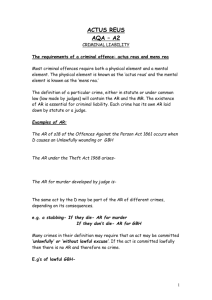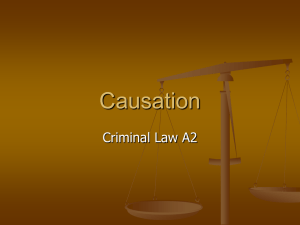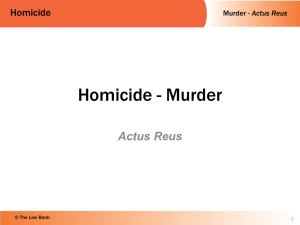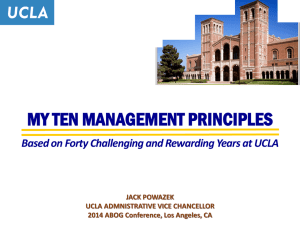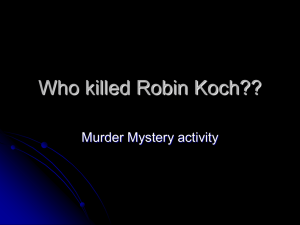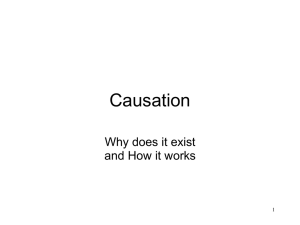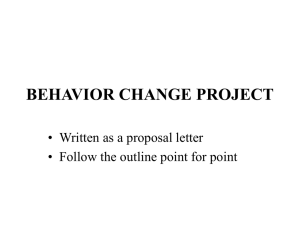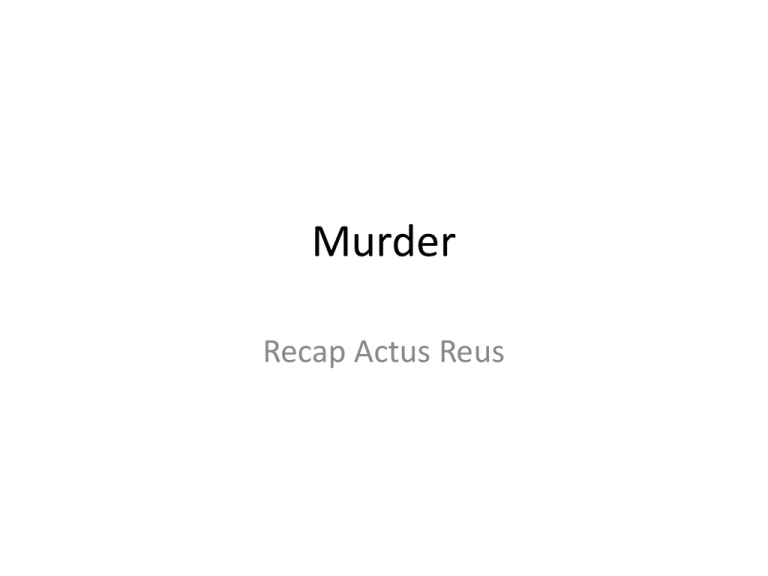
Murder
Recap Actus Reus
Definition of murder
• The unlawful killing of a reasonable creature
in being and under the Queen’s peace with
malice aforethought, express or implied.
Actus Reus of murder
• Unlawful killing of a reasonable creature in being and
under the Queen’s peace.
• The killing must be unlawful (i.e. Not done in selfdefence or in the prevention of a crime – remember
must be reasonable force in the circumstances)
• A/R can be an act or an omission
• Murder is a result crime (D cannot be guilty unless
his/her act/omission caused the death
Omissions
• General rule: No liability for failure to act
Except:
– A contractual duty
– A duty because of a relationship
– A duty undertaken voluntarily
– A duty which arises because the defendant has set
in motion a chain of events
Cases
Which omission does each case belong to?
•
•
•
•
Pittwood (1902)
Gibbins & Proctor (1918)
Stone & Dobinson (1977)
Miller (1983)
Reasonable creature in being
• Is a foetus in the womb a ‘reasonable creature in
being’?
• Is a victim still considered to be alive (and so a
‘reasonable creature in being’) if they are ‘brain dead’
but being kept alive by a life-support machine?
• Attorney-General’s Reference (No3 of 1994) (1997)
• Malcherek (1981)
Last parts of the actus reus
Why was the following Act introduced?
– Law Reform (Year and a Day Rule) Act 1996
• Explain the meaning of the Queen’s peace.
Quick Quiz (close your books)
1. Give the definition of murder
2. What is the normal rule on whether an omission can
be sufficient for the A/R of murder?
3. Give two case examples where an omission could be
the A/R of murder.
4. Has the D committed the A/R of murder if
1.
2.
He kills a foetus in the womb so that the child is born dead?
He injures a foetus in the womb and the child is born alive but
dies of its injuries?
5. The definition of murder includes the phrase ‘under
the Queen’s Peace’. What is the effect of this phrase?
Causation
• Where a consequence must be proved, the
prosecution has to show that the D’s conduct
was:
– The factual cause of the consequence; and
– The legal cause of the consequence; and
– That there was no intervening act which broke
the chain of causation
Factual Cause
• The D can only be guilty if the consequence
would not have happened ‘But for’ the D’s
conduct.
• BUT FOR TEST
• Pagett (1983)
• White (1910)
Legal Cause
De Minimis rule
• The D’s conduct must be
more than a ‘minimal’ cause
of the consequence
• Cato (1976)
• Kimsey (1996)
Thin Skull rule
• The D must also take the
victim as he finds him.
• i.e. if the victim has something
unusual about his physical or
mental state which makes any
injury more serious, then D
will be liable for the more
serious injury.
• Blaue (1975)
Intervening acts
The chain of causation can be broken by:
• An act of a third party
• The victim’s own act
• A natural but unpredictable act
–
–
–
–
–
Smith (1959)
Cheshire (1991)
Jordan (1956)
Roberts (1971)
Williams (1992)
Rules on causation
Was D’s conduct the factual cause of the
consequence?
No
NOT GULITY
No
Not Guilty
Yes
Not guilty
Yes
Was D’s conduct more than a minimal
cause of the consequence?
Yes
Did an intervening act break the chain of
causation?
No
D legally and factually caused consequence
and will be guilty if he has the required
mens rea.
Scenario 1
• Jane is angry because Karina is pregnant by
Jane’s boyfriend. When Karina is eight
months pregnant, Jane stabs her in the
stomach, intending to kill the feotus. Karina is
rushed to hospital where a caesarian section is
carried out. The baby is alive when it is
removed from Karina’s womb, but dies two
hours later.
Scenario 2
• Anya is offered a lift home by Barnaby. After a
few minutes she realised he is driving away
from her home. He then puts his hand on her
thigh as he is driving and says that they can
enjoy themselves. Anya is so afraid that she
jumps out of the car while it is going at about
40mph. She is hit by another car and killed.
Scenario 3
• Toyah stabs Steve in the arm. His injury is not
serious but he needs stitches, so a neighbour
takes Steve to hospital in his car. On the way
to the hospital the car crashes and Steve
sustains serious head injuries, from which he
dies.
Scenario 4
• Lily decides to kill kevin. She takes his shotgun
and loads it. She waits until he has gone to
sleep and then goes into his bedroom and
shoots him in the head. Unknown to her,
Kevin died from a drug overdose twenty
minutes before she shot him.
Scenario 5
• Ross stabs Paul in the chest. Paul is taken to
hospital where he is given a blood transfusion.
Unfortunately, he is given the wrong blood
and he dies.
Quick Quiz
1.
For causation, the D’s act or omission must be the factual cause of
V’s death. Give a case or example where’s D’s act or omission was
NOT the factual cause of V’s death.
2.
To what extent must D’s act or omission be the cause of V’s death
for it to be considered to be the legal cause?
3.
Give a case (name and facts) where medical intervention did NOT
breach the chain of causation.
4.
Give a case (name and facts) where medical intervention DID
breach the chain of causation.
5.
What is the rule where V’s own intervening act leads to his death?

